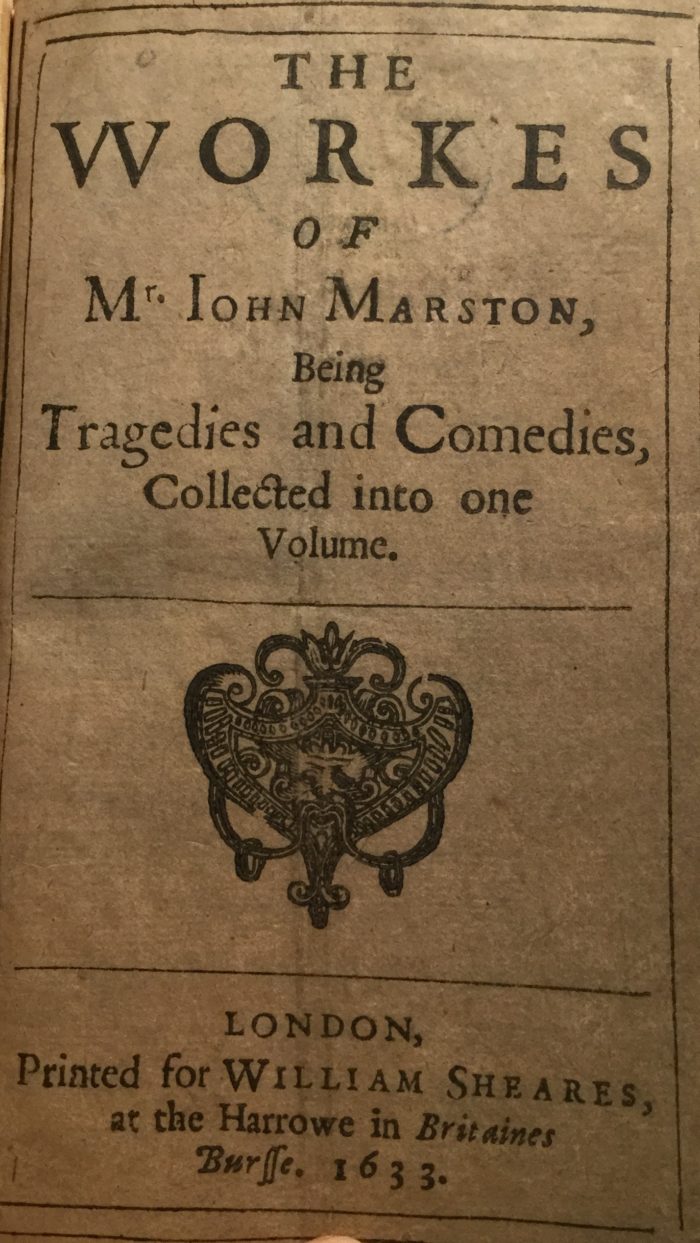Why edit Marston?

Title page of the first issue of Marston's 'Workes' (1633)
When William Sheares attempted to publish The Workes of Mr. John Marston in 1633, he only managed to bring together six plays (The Malcontent being one notable omission), and before the volume had left the press Marston intervened to have his name removed from the title page. This is an inauspicious but symptomatic start for an author who has never had the benefit of a comprehensive and properly edited collected edition. The nearest approach to a satisfactory ‘complete’ edition is that edited by A. H. Bullen way back in 1887, but since that time the outlines of the Marston canon have changed radically, as have the protocols of editing. In the twentieth century, an old-spelling edition of just the plays was produced in three volumes by H. Harvey Wood (1934-39), but this collection falls well short of what a Marston edition needs to be. Wood lacked the necessary bibliographical expertise, and neither his textual work nor his commentary come up to modern standards. Subsequently there have been some excellent one-off Marston volumes, but no one has attempted to re-edit his work as a complete integrated corpus. As a result, Marston is much less well known than he deserves. His critical fortunes have lagged behind those of his contemporaries, and many of his plays have languished outside the theatre, with little history of revivals beyond their original productions.
So, for example, there is much uncertainty about the shape and limits of the Marston canon. A significant proportion of his plays were produced in collaboration with other writers or have traces of other writers’ hands in them (The Malcontent, Eastward Ho!, Histriomastix, The Insatiate Countess), and the situation is complicated by the existence of other plays outside the canon which have been claimed as possible Marston texts (Lust’s Dominion, The Family of Love). Conversely, some scholars feel that Histriomastix might not be a Marston play at all. One function of a new edition would be to define the boundaries of the canon more clearly, and to look closely at other unsolved puzzles, such as the date and sequence of his writings. Only then can Marston be approached with the necessary confidence about what he wrote and when he wrote it.
Another function of a complete edition would be to explain his writing with sufficient thoroughness. Marston’s language is often difficult and obscure. His plays are full of complex philosophical references, to the works of Aristotle and the classic authors, or to moderns such as Machiavelli, Montaigne and others. He was interested in French and Italian literature, and often draws on foreign languages. Equally, he often dwells on matters of forgotten topicality, such as fashions, court behaviour, religious belief, manners, and music. Even more strikingly, he is notorious for using bizarre and outrageous words, many of which he may have invented – glibbery, anyone? Or maybe bespurtle, gargalize, knurly, pustulent or paraphonalian? Indeed, Marston probably coined the compound adjective ‘new-minted’, as in ‘new-minted epithets’ (The Scourge of Villainy, 1598). Since a comprehensive Marston commentary has yet to be written, our editors will need to supply a close and detailed explanation of his meanings, more or less line by line.
But the fundamental challenge is to decide what Marston wrote, and to establish a coherent and authoritative text. Marston’s works were issued during his lifetime as cheap sixpenny quartos, which survive in more than 200 copies scattered around the world, mostly in British and American libraries, but some as far flung as Australia and New Zealand. There are also a few manuscripts, particularly relating to the short entertainments that he wrote for aristocratic or royal audiences. These books and manuscripts have never been systematically or comprehensively surveyed, and only by consulting as many as we can, and comparing their pages for changes and variants, can we be sure we are printing the text as Marston wished it to appear. The core work of the edition will be to establish a text that represents Marston’s writing as completely and accurately as can be achieved, and then to contextualize it so that modern readers can understand the nuances and complexities of his meaning. After that, we hope that Marston will stand a better chance of reaching a much wider audience, and maybe of appearing more frequently in today’s theatres.
